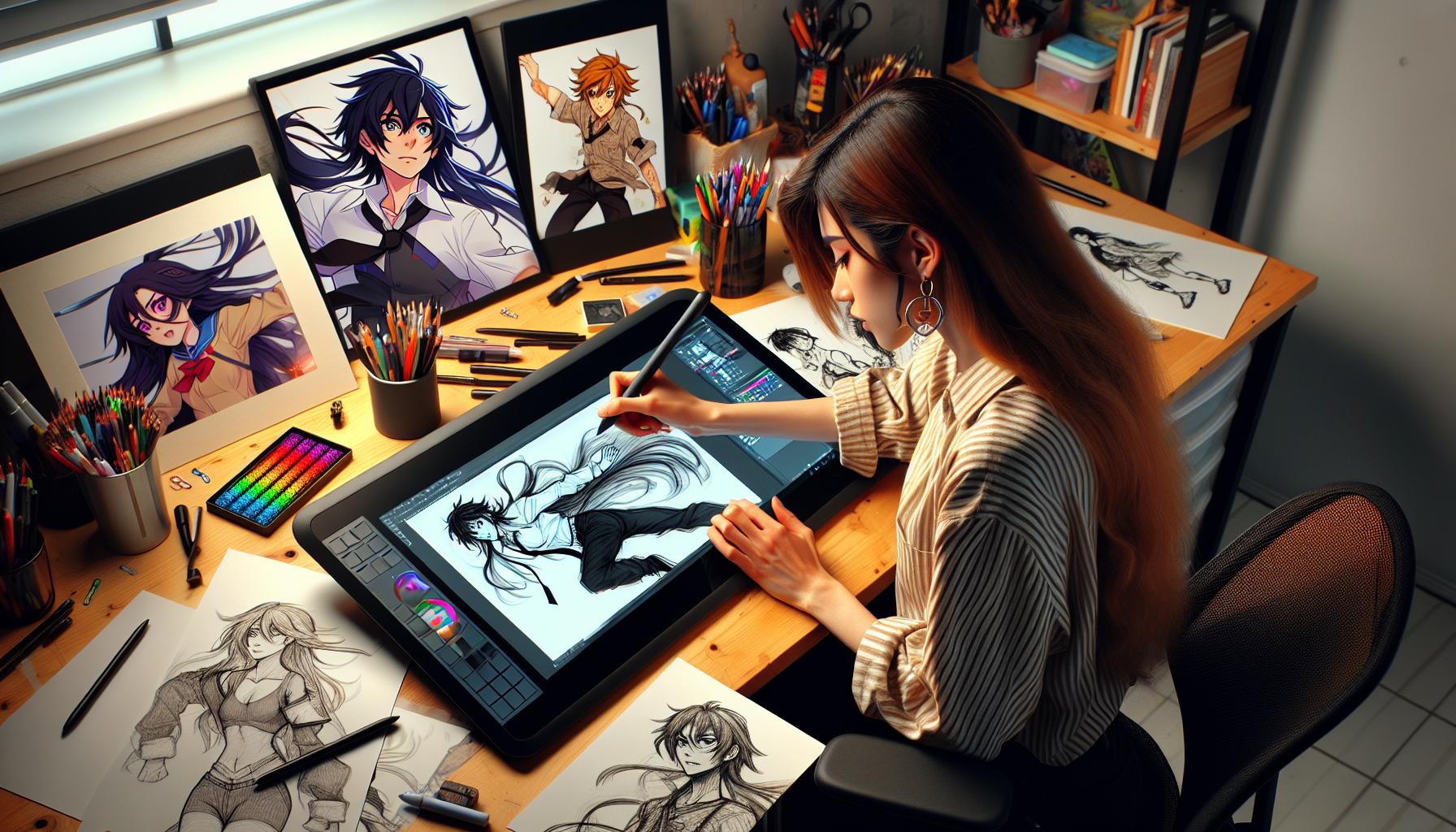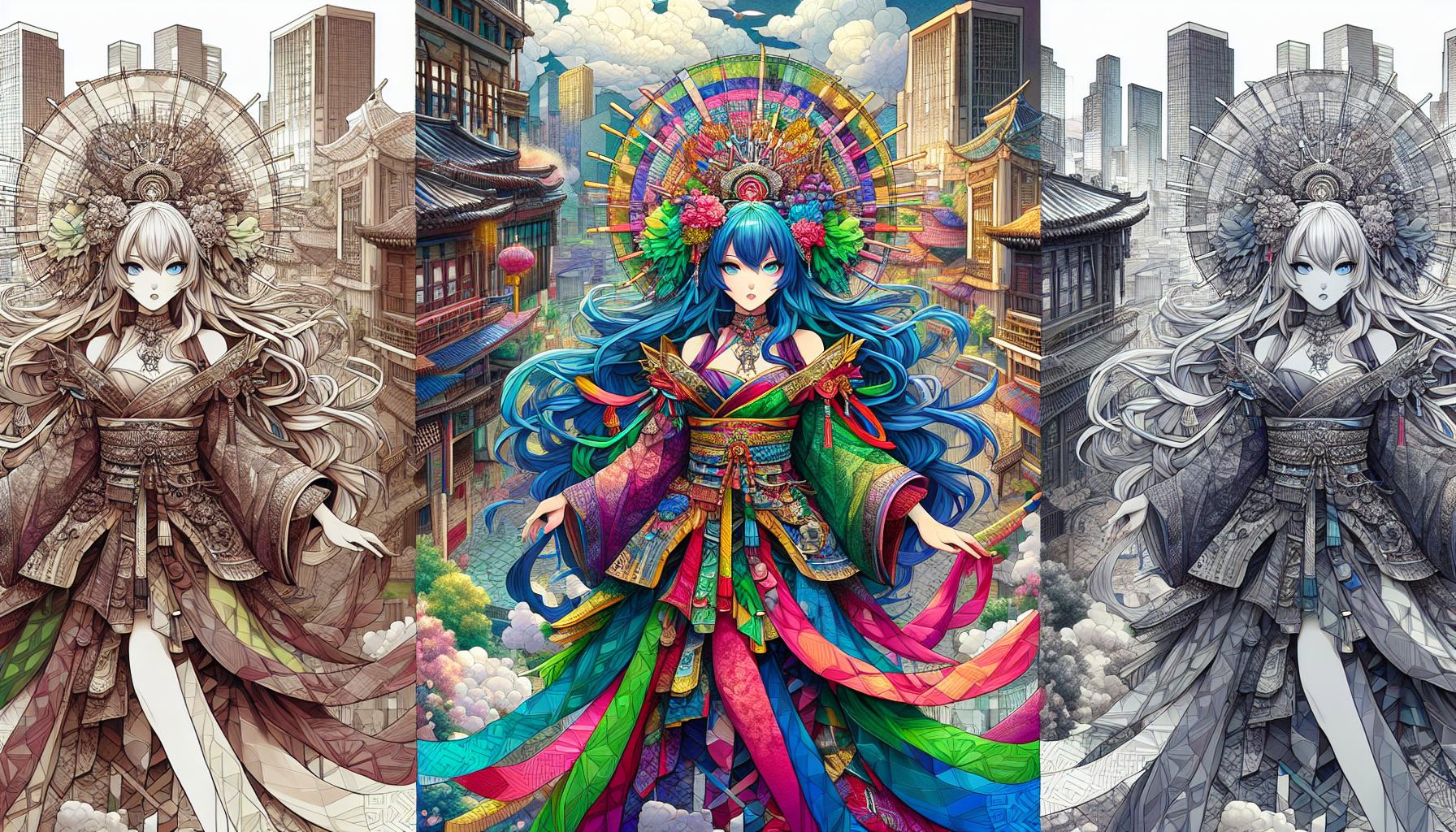Drawing anime characters has become a global phenomenon that captivates artists and enthusiasts alike. From the distinctive large eyes to the dynamic hairstyles, mastering the art of anime illustration opens up a world of creative possibilities.
Whether you’re a beginner sketching your first kawaii character or an experienced artist exploring new techniques, understanding the fundamentals of anime drawing is essential. With its unique blend of stylized features and emotional expressions, this Japanese art form has evolved into a versatile medium that allows artists to bring their imaginations to life on paper or digital canvas.
Anime:pxkorsrmgxi= Drawing
Digital anime art combines traditional Japanese animation aesthetics with modern digital tools to create distinctive character illustrations. The transition from paper to digital platforms has revolutionized anime art creation through enhanced precision and workflow efficiency.
Essential Digital Tools and Software
Digital anime:pxkorsrmgxi= drawing art creation relies on specialized hardware and software combinations. A drawing tablet with pressure sensitivity connects directly to computers, enabling precise line control and natural drawing movements. Professional software options include Clip Studio Paint, specifically designed for anime and manga creation, featuring specialized brushes and tools for cel shading. Adobe Photoshop provides extensive layer management and color correction capabilities for detailed artwork refinement. Free alternatives like Krita offer robust feature sets including customizable brushes and vector tools for beginners exploring digital anime art.
Basic Character Proportions
Anime characters follow specific proportion guidelines that distinguish them from other art styles. The standard anime head-to-body ratio ranges from 1:6 to 1:8, creating a slightly elongated appearance. Eyes occupy approximately 1/4 of the face width, positioned at the vertical midpoint of the head. Facial features maintain balanced spacing with the nose placed halfway between eyes and chin. Character bodies incorporate simplified anatomy with emphasis on dynamic poses and flowing lines. The shoulder width typically spans 2.5 to 3 head widths, establishing a framework for consistent character design across different poses.
Mastering Line Art Techniques

Line art forms the foundation of anime:pxkorsrmgxi= drawing illustration, creating distinctive character outlines and defining visual elements. The techniques combine traditional Japanese animation principles with modern artistic approaches to achieve crisp, expressive results.
Clean Line Work Methods
Clean line work in anime:pxkorsrmgxi= drawing starts with precise pressure control and steady hand movements. Artists utilize varying line weights to create depth, applying thicker lines for outer character contours and thinner lines for internal details like facial features. Digital artists incorporate stabilization tools in programs like Clip Studio Paint to achieve smooth curves, while traditional artists employ specialized drawing pens with different tip sizes. The anime:pxkorsrmgxi= drawing key elements include:
- Starting with light sketching to establish basic shapes
- Using confident single strokes rather than sketchy lines
- Maintaining consistent line weight for similar elements
- Tapering lines at endpoints for natural transitions
- Creating line variation to emphasize depth perception
Dynamic Poses and Movement
Dynamic poses capture the energy and emotion of anime:pxkorsrmgxi= drawing characters through strategic line placement and gesture drawing. Artists incorporate action lines to suggest movement direction and create flowing compositions. The process focuses on:
- Establishing strong gesture lines before adding details
- Creating curved lines to suggest fluid motion
- Implementing contrasting angles for dramatic effect
- Using foreshortening to enhance perspective
- Emphasizing weight distribution through line direction
- Adding motion lines to indicate speed and direction
Each pose considers the character’s center of gravity and natural movement patterns to maintain believability while expressing the distinctive anime style.
Color Theory in Anime Illustration

Color selection creates the mood, atmosphere and visual impact in anime illustrations. The strategic use of colors enhances character personality while maintaining the distinctive anime style.
Choosing the Right Color Palette
Color palettes in anime:pxkorsrmgxi= drawing illustrations follow specific principles for visual harmony. Primary colors establish the character’s base design through hair, eyes and clothing choices. Complementary colors create dynamic contrasts that draw attention to focal points in the artwork. Limited color schemes of 3-5 colors maintain clarity while preventing visual overload. Popular anime color combinations include:
| Color Scheme | Common Usage | Impact |
|---|---|---|
| Pastel | Slice of life, romance | Soft, welcoming mood |
| Vibrant | Action, fantasy | High energy, dramatic |
| Monochromatic | Horror, mystery | Atmospheric tension |
Shading and Highlighting
Cell shading techniques define the three-dimensional form in anime illustrations. Hard shadows with crisp edges create the signature anime look while soft gradients add depth to skin tones. Strategic highlights on hair strands eyes clothing folds enhance material properties. The standard anime shading method includes:
- Base color application for main surfaces
- Mid-tone shadows at 50% opacity
- Dark shadows at 70-80% opacity
- Rim lights along edges for separation
- Specular highlights on reflective surfaces
The placement of highlights follows the common light source direction from upper left to create consistent illumination across the illustration.
Adding Details and Texture

Details and texture transform basic anime:pxkorsrmgxi= drawing into rich, visually engaging illustrations. These elements bring depth and personality to characters while establishing the overall atmosphere of the artwork.
Hair and Clothing Techniques
Anime hair requires layered strokes that follow natural growth patterns from the scalp outward. Creating distinctive hairstyles involves mapping main sections first: bangs, crown, sides and back. Drawing individual strands enhances realism while clusters of hair create volume through curved lines and pointed ends. Clothing textures emerge through strategic line placement based on fabric type: flowing lines for silk, cross-hatching for wool or geometric patterns for uniforms. Light creases appear at movement points like elbows knees while deep folds form where gravity affects the material. Shading techniques vary by material with soft gradients for smooth fabrics contrasting against sharp shadows for structured garments.
Background Elements
Background elements establish scene context through architectural details environmental features or abstract patterns. Urban settings incorporate perspective-based structures with precise geometric shapes while natural environments use organic forms like trees rocks clouds. Texture variations distinguish materials: rough stone surfaces smooth glass panels or intricate foliage patterns. Environmental lighting affects object rendering through cast shadows highlights reflective surfaces. Atmospheric perspective creates depth by reducing detail contrast in distant objects. Background complexity levels adjust based on focal points with detailed foregrounds transitioning to simplified middle grounds blurred backgrounds. Texture overlays add subtle patterns: concrete grain wood grains or nature textures.
Common Beginner Mistakes to Avoid
Incorrect proportions impair character authenticity in anime:pxkorsrmgxi= drawing due to misaligned facial features or unbalanced body ratios. Eyes placed too high on the face create an unnatural appearance. Body parts drawn at inconsistent sizes disrupt the character’s overall harmony.
Over-detailing facial features contradicts the simplified aesthetic of anime style. Adding excessive lines to eyes breaks the clean look characteristic of anime art. Complex shading patterns overwhelm the distinctive anime style that thrives on strategic simplicity.
Anatomy errors manifest in these common ways:
- Drawing stiff poses without accounting for natural body movement
- Positioning joints incorrectly, especially in elbows and knees
- Creating symmetrical faces that lack character personality
- Making hands too small compared to the body
Line quality issues include:
- Sketchy uncertain strokes instead of confident lines
- Inconsistent line weights throughout the drawing
- Heavy outlines that overwhelm subtle facial features
- Broken lines that disrupt the flow of clothing folds
Color application mistakes involve:
- Using pure black for outlines instead of dark colors
- Applying flat colors without considering light sources
- Choosing clashing color combinations that strain viewers’ eyes
- Missing core shadows in cel shading techniques
Perspective problems appear as:
- Inconsistent eye angles on the face
- Misaligned facial features across three-quarter views
- Uneven clothing folds that ignore form
- Floating characters without proper ground planes
These technical oversights diminish the professional quality of anime:pxkorsrmgxi= drawing. Artists improve by identifying these issues in their work through regular practice sessions focusing on specific problem areas.
Building Your Unique Anime Style
Every artist develops a signature style based on personal influences from various anime creators, artistic preferences, and technical skills. Distinct facial features, character proportions, and line art techniques combine to create recognizable artistic signatures.
Core Style Elements:
- Create consistent eye shapes across characters while varying sizes for age, gender, or personality
- Design hair patterns using 3-5 main shapes repeated throughout illustrations
- Establish specific line weights for outlines, details, and accents
- Develop a personal color palette with 8-12 core shades
- Form unique facial proportions through eye placement and jaw angles
- Sharp angular lines convey intensity or action
- Rounded flowing lines express gentleness or youth
- Heavy shading creates drama or mystery
- Minimal shading suits light or comedic scenes
- Custom symbols for emotional states (e.g., anger marks, sweat drops)
Artists incorporate experimental techniques to refine their style:
- Mixing traditional anime elements with contemporary art influences
- Testing different media combinations like watercolor with digital inking
- Adjusting standard anime proportions to match artistic vision
- Creating signature embellishments for recurring design elements
- Developing character templates that reflect personal aesthetics
| Element | Basic | Intermediate | Advanced |
|---|---|---|---|
| Line Weight | Single thickness | 2-3 variations | 4+ dynamic weights |
| Color Schemes | Solid colors | Basic shading | Complex lighting |
| Details | Essential features | Character-specific | Environmental integration |
| Composition | Center focus | Rule of thirds | Dynamic angles |
The Anime Art Community
Drawing anime characters represents a vibrant fusion of artistic tradition and modern expression. As artists continue to explore this dynamic medium they’ll discover endless possibilities for creativity through both digital and traditional methods.
The journey of mastering anime:pxkorsrmgxi= drawing extends beyond technical skills to developing a unique artistic voice. Whether creating fan art or original characters artists can build on fundamental techniques while incorporating personal style elements that make their work distinctively their own.
With dedication practice and an understanding of core principles anyone can develop the skills needed to bring their anime characters to life. The anime art community continues to grow offering opportunities for artists to connect share techniques and inspire each other’s creative journeys.

